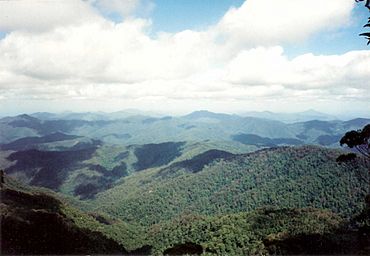New England National Park facts for kids
Quick facts for kids New England National ParkNew South Wales |
|
|---|---|
|
IUCN Category Ib (Wilderness Area)
|
|

Along the escarpment there are a number of lookouts providing expansive views.
|
|
| Nearest town or city | Dorrigo |
| Established | May 1937 |
| Area | 673 km2 (259.8 sq mi) |
| Managing authorities | NSW National Parks & Wildlife Service |
| Website | New England National Park |
| See also | Protected areas of New South Wales |
The New England National Park is a special national park in New South Wales, Australia. It's a protected area located on the Northern Tablelands region. This park covers about 67,303 hectares (that's like 673 square kilometers!). It was created in May 1935.
You can find the park about 560 kilometers north of Sydney. It's also 85 kilometers east of Armidale and 65 kilometers west of Coffs Harbour. The closest small town is Ebor, which is about 20 kilometers away.
New England National Park is part of a bigger World Heritage Site called the Gondwana Rainforests of Australia. This site was recognized in 1986. It was also added to the Australian National Heritage List in 2007. This means it's super important for its natural beauty and history.
Contents
Discover New England National Park
More than 1,000 different kinds of plants grow here. This huge variety of plants attracts many different birds.
A Park with a Rich Past
People started wanting to protect this area way back in the 1920s. A person named Phillip Wright helped lead the effort. Most of the land became a reserve in 1931. Then, in 1935, it was officially set aside for everyone to enjoy.
The national park was officially opened in 1937. The Governor General, Lord Gowrie, did the honors. Even before that, people knew how beautiful this wild place was.
The park became a World Heritage Site in 1986. It's part of the Gondwana Rainforests of Australia. This group of rainforests was added to the Australian National Heritage List in 2007.
Where is the Park Located?
The park sits on a steep edge of the Northern Tablelands plateau. It has amazing cliffs, rugged hills, and many streams. To the west, rivers like the Nymboida, Guy Fawkes, and Styx flow across the tablelands. To the east, you'll find the thick forests of the Bellinger River valley.
Two other national parks are next to New England National Park. The Cunnawarra National Park is to the northwest. The Bellinger River National Park is in the northeast corner.
Amazing Views from Point Lookout
Most visitors go to the Point Lookout area. This spot is 1,563 meters above sea level. On a clear day, you can even see the Tasman Sea from here! Point Lookout is one of the highest places north of the Snowy Mountains. It's also the second tallest mountain in this region.
Plants and Animals of the Park

New England National Park is known for its wide variety of plants and animals. The park has many different types of forests. These include sub-tropical, warm temperate, and cool temperate rainforests in the higher areas. You can also find sclerophyll forests, sub-alpine woodlands, heathlands, and swamplands. In the eucalyptus forests, you'll see trees like Brush box, Sydney blue gum, and Tallow-wood.
Heathland areas are found at Wrights Lookout and other spots. Experts used to think there were about 500 different plant species here. Now, they believe there are around 1,000! These plants include snow gums, Antarctic beech trees, tree ferns, and red cedars.
Many mammals live in the park too. Some of them are Dingos, koalas, tiger quolls, common bentwing bats, brown antechinuses, and northern brown bandicoots.
Meet the Park's Birds
At least 100 different kinds of birds have been seen in the park. Some of the larger birds include the wedge-tailed eagle, greater sooty owl, sulphur-crested cockatoo, and superb lyrebird. You might also spot Eastern whipbirds, eastern bristlebirds, crimson rosellas, Australian king parrots, and several types of honeyeaters.
BirdLife International has named this park an Important Bird Area (IBA). This is because it's home to rare birds like the rufous scrub-bird. It also supports populations of flame and pale-yellow robins, paradise riflebirds, green catbirds, regent bowerbirds, and Australian logrunners.
Planning Your Visit
The park has many walking tracks that let you explore the higher parts.
You can find some places to stay inside the park at Banksia Point. If you visit in winter, make sure to bring warm clothes! Because the park is so high up, it often gets snow and very cold temperatures.
See also
In Spanish: Parque nacional Nueva Inglaterra para niños



